|
|
 |
| ............................................................. |
|
|
| ........................................................ |
| From
the Editor |

|
Editorial
A. Abyad (Chief Editor) |
........................................................
|
|
Original contribution/Clinical Investigation
Diabetes Mellitus
- Knowledge, Management and Complications: Survey
report from Faisalabad-Pakistan
Ijaz Anwer, Ahmad Shahzad, Kashmira Nanji, Farah
Haider, Muhammad Masood Ahmad
Alanine aminotransferase
indicates excess weight and dyslipidemia
Mehmet Rami Helvaci, Orhan Ayyildiz* Mustafa
Cem Algin, Yusuf Aydin, Abdulrazak Abyad, Lesley
Pocock
Comparative Analysis of Antimicrobial Peptides
Gene Expression in Susceptible/Resistant Mice
Macrophages to Leishmania major Infection
Hamid Daneshvar, Iraj Sharifi, Alireza Kyhani,
Amir Tavakoli Kareshk, Arash Asadi
Does
socio-economic status of the patients have effect
on clinical outcomes after coronary artery bypass
grafting surgery?
Forough Razmjooei, Afshin Mansourian, Saeed
Kouhpyma
Comparison of the uterine
artery Doppler indices during pregnancy between
gestational diabetes and diabetes mellitus and
healthy pregnant women
Nazanin Farshchian, Farhad Naleini, Amir Masoud
Jaafarnejhad,
Parisa Bahrami Kamangar
Survey single dose
Gentamicin in treatment of UTI in children with
range of 1 month to 13 years old in Jahrom during
2015
Ehsan Rahmanian, Farideh Mogharab,
Vahid Mogharab
Evaluation of control of
bleeding by electro cauterization of bleeding
points of amplatz sheath tract after percutaneous
nephrolithotomy (PCNL) in Jahrom Peymanieh hospital
during year 2015-2016
Ali Reza Yousefi , Reza Inaloo
Comparison of the three-finger
tracheal palpation technique with triple ID
formula to determine endotracheal tube depth
in children 2-8 years in 2016-2017
Anahid Maleki, Alireza Ebrahim Soltani, Alireza
Takzare, Ebrahim Espahbodi,
Mehrdad Goodarzi , Roya Noori
Effect of Sevoflurane
and Propofol on pulmonary arterial pressure
during cardiac catheterization in children with
congenital heart diseases
Faranak Behnaz, Mahshid Ghasemi , Gholamreza
Mohseni, Azim Zaraki
Population and Community Studies
Prevalence
and risk factors of obesity in children aged
2-12 years in the Abu Dhabi Islands
Eideh Al-Shehhi, Hessa Al-Dhefairi, Kholoud
Abuasi, Noora Al Ali, Mona Al Tunaiji, Ebtihal
Darwish
Study and comparison
of psychological disorders in normal students
and students with multiple sclerosis in Shahrekord
Neda Ardestani-Samani, Mohammad Rabiei, Mohammad
Ghasemi-Pirbalooti, Asghar Bayati, Saeid Heidari-Soureshjani
Comparative
study of self-concept, physical self-concept,
and time perspective between the students with
multiple sclerosis and healthy students in Shahrekord
Neda Ardestani-Samani, Mohammad Rabiei, Mohammad
Ghasemi-Pirbalooti, Asghar Bayati, Saeid Heidari-Soureshjani
Relationship
between Coping Styles and Religious Orientation
with Mental Health in the Students of the Nursing-Midwifery
Faculty of Zabol
Nasim Dastras, Mohsen Heidari Mokarrar, Majid
Dastras, Shirzad Arianmehr
Tuberculosis in Abadan,
Iran (2012-2016): An Epidemiological Study
Ali-Asghar ValiPour, Azimeh Karimyan, Mahmood
Banarimehr, Marzieh Ghassemi, Maryam Robeyhavi,
Rahil Hojjati,
Parvin Gholizadeh
Family Stability and Conflict
of Spiritual Beliefs and Superstitions among
Yazdi People in Iran: A Qualitative Study
Zahra Pourmovahed , Seyed Saied Mazloomy Mahmoodabad
; Hassan Zareei Mahmoodabadi ; Hossein Tavangar
; Seyed Mojtaba Yassini Ardekani ; Ali Akbar
Vaezi
A comparative
study of the self-actualization in psychology
and Islam
Simin Afrasibi, Zakieh Fattahi
The effectiveness
of cognitive - behavioral therapy in reducing
the post-traumatic stress symptoms in male students
survivors of earthquake in the central district
of Varzeghan
Sakineh Salamat, Dr.Ahad Ahangar, Robab Farajzadeh
Reviews
Effects and mechanisms
of medicinal plants on stress hormone (cortisol):
A systematic review
Kamal Solati, Saeid Heidari-Soureshjani, Lesley
Pocock
Comparing Traditional
and medical treatments for constipation : A
Review Article
Mohammad Yaqub Rajput
A review of anti-measles
and anti-rubella antibodies in 15- 25 year old
women in Jahrom City in 2011
Ehsan Rahmania , Farideh Mogharab, Vahid Mogharab
Review of percutaneous
nephrolithotomy in children below 12 years old
in Jahrom hospital, during 2010-2014
Ali Reza Yousefi , Reza Inaloo
Physical and
mental health in Islam
Bahador Mehraki, Abdollah Gholami
International Health Affairs
The Challenges of Implementation
of Professional Ethics Standards in Clinical Care
from the viewpoint of Nursing Students and Nurses
Saeedeh Elhami, Kambiz Saberi, Maryam Ban, Sajedeh
Mousaviasl, Nasim Hatefi Moadab, Marzieh Ghassemi
Cognitive Determinants
of Physical Activity Intention among Iranian Nurses:
An Application of Integrative Model of Behavior
Prediction
Arsalan Ghaderi, Firoozeh Mostafavi, Behzad Mahaki,
Abdorrahim Afkhamzadeh,
Yadolah Zarezadeh , Erfan Sadeghi
Effect of resilience-based
intervention on occupational stress among nurses
Hossein Jafarizadeh, Ebrahim Zhiyani, Nader
Aghakhani, Vahid Alinejad, Yaser Moradi
Education and Training
Calculation of Salaries
and Benefits of Faculty Members in the Ministry
of Health and Medical Education of Iran
Abdolreza Gilavand
The effect of education
on self-care behaviors of gastrointestinal side
effects on patients undergoing chemotherapy
Shokoh Varaei, Ehsan Abadi Pishe, Shadan Pedram
Razie, Lila Nezam Abadi Farahani
Creating and
Validating the Faith Inventory for Students
at Islamic Azad University of Ahvaz
Solmaz Choheili, Reza Pasha, Gholam Hossein
Maktabi, Ehsan Moheb
Creating
and Validating the Adjustment Inventory for
the Students of Islamic Azad University of Ahvaz
Homa Choheili, Reza Pasha, Gholam Hossein Maktabi,
Ehsan Moheb
Evaluating
the Quality of Educational Services from the
Viewpoints of Radiology Students of Ahvaz Jundishapur
University of Medical Sciences
Abdolreza Gilavand, Jafar Fatahiasl
An Investigation
of Psychosocial aspect of Iranian Nursing Students'
Clinical Setting
Mahsa Boozaripour , Zanyar Karimi, Sima Zohari
Anbohi, Amir Almasi-Hashiani, Fariba Borhani
Clinical Research and Methods
Comparison of the
Antibacterial Effects of Chlorhexidine Mouth
washes with Jaftex Mouth wash on Some Common
Oral Microorganisms (An in Vitro Study)
Ebrahim Babadi, Zahra Bamzadeh, Fatemeh Babadi
Study of the effect
of plasma jet on Fusarium isolates with ability
to produce DON toxins
Elham Galin Abbasian, Mansour Bayat, Arash chaichi
Nosrati, Seyed Jamal Hashemi, Mahmood Ghoranneviss
The comparison of
anti-inflammatory effect in two methods of topical
dexamethasone injection and topical application
of ginger alcoholic extract after removing mandibular
wisdom teeth
Sahar Zandi, Seyyed Muhammadreza Alavi, Kamran
Mirzaie, Ramin Seyedian, Narges Aria, Saman
Jokar
The effect of curcumin
on growth and adherence of major microorganisms
causing tooth decay
Leila Helalat, Ahmad Zarejavid, Alireza Ekrami,
Mohammd Hosein Haghighizadeh, Mehdi Shiri Nasab
|
|
Chief
Editor -
Abdulrazak
Abyad
MD, MPH, MBA, AGSF, AFCHSE
.........................................................
Editorial
Office -
Abyad Medical Center & Middle East Longevity
Institute
Azmi Street, Abdo Center,
PO BOX 618
Tripoli, Lebanon
Phone: (961) 6-443684
Fax: (961) 6-443685
Email:
aabyad@cyberia.net.lb
.........................................................
Publisher
-
Lesley
Pocock
medi+WORLD International
11 Colston Avenue,
Sherbrooke 3789
AUSTRALIA
Phone: +61 (3) 9005 9847
Fax: +61 (3) 9012 5857
Email:
lesleypocock@mediworld.com.au
.........................................................
Editorial
Enquiries -
abyad@cyberia.net.lb
.........................................................
Advertising
Enquiries -
lesleypocock@mediworld.com.au
.........................................................
While all
efforts have been made to ensure the accuracy
of the information in this journal, opinions
expressed are those of the authors and do not
necessarily reflect the views of The Publishers,
Editor or the Editorial Board. The publishers,
Editor and Editorial Board cannot be held responsible
for errors or any consequences arising from
the use of information contained in this journal;
or the views and opinions expressed. Publication
of any advertisements does not constitute any
endorsement by the Publishers and Editors of
the product advertised.
The contents
of this journal are copyright. Apart from any
fair dealing for purposes of private study,
research, criticism or review, as permitted
under the Australian Copyright Act, no part
of this program may be reproduced without the
permission of the publisher.
|
|
|
| November 2017
- Volume 15, Issue 9 |
|
|
Tuberculosis in Abadan,
Iran (2012-2016): An Epidemiological Study
Ali-Asghar ValiPour
Azimeh Karimyan
Mahmood Banarimehr
Marzieh Ghassemi
Maryam Robeyhavi
Rahil Hojjati
Parvin Gholizadeh
Student
Research Committee, Abadan School of Medical
Sciences, Abadan, Iran
Corresponding author:
Marzieh Ghassemi
Student Research Committee,
Abadan School of Medical Sciences,
Abadan, Iran
|
Abstract
Determining
the course of the disease and its changes
over time can be of great importance in
assessing the rate and manner of access
to the strategies used to control illnesses.
This retrospective
descriptive-analytic study was carried
out with a survey of patients with tuberculosis
in the affiliated cities of the Abadan
School of Medical Sciences during a period
of 5 years. The required data were collected
from the “TB Register” software
as well as information registered by TB
health experts. The Kolmogorov Smirnov,
Independent-T, Mann Whitney U and Wilcoxon
tests were used for analysis of data using
SPSS 22- software.
In this study,
720 patients with tuberculosis were studied,
of whom 62.9% were male. 73.6% of patients
lived in urban areas. The prevalence of
tuberculosis is 22.34 per 100,000 population,
of which 15.36 per 100,000 is pulmonary
tuberculosis. Mean age of patients was
41.39 (SD±17.69) years with a range
of 4-92 years.
Considering the
fact that tuberculosis is a life-limiting
disease and is most prevalent in the young
age group of society, who are considered
as the main capital and workforce, educating
people who are at risk can significantly
contribute to the prevention of disease.
Key words:
Epidemiology, Tuberculosis, Abadan
|
Today, tuberculosis is one of the biggest health
problems in the world. The disease burden of
Tuberculosis (TB), the major cause of death
from single-agent infectious diseases in the
world (even more than AIDS, malaria and measles),
ranks tenth in terms of the global burden of
disease (1, 2) . One in three people in the
world is suspected to have been infected with
TB, and one person is added every second (1,
3). In 2015, 10.4 million people worldwide have
been infected with TB, with an estimated 1.8
million deaths. Also, more than 95% of deaths
from TB occur in low-to-middle-income countries
where 75% of the cases are seen in the economically
active age group (15-54 years) (3-5).
In the last few decades, TB prevalence has
decreased sharply in Iran; that is to say the
prevalence rate decreased from 142 cases per
100,000 populations in 1964 to 12.59 per 100,000
populations in 2015, which indicates a decrease
of more than tenfold. Further, the highest TB
incidence rate belonged to the population aged
65 and above (3, 6). Since Iran is a neighbor
of Afghanistan and Pakistan, which are among
the countries with the highest burden, as well
as Iraq (due to its crisis in recent years)
and the newly independent countries of northern
Iran, which suffer from a high prevalence of
multi-drug resistant TB, there is need to pay
more attention to the disease (1, 3, 7).
Considering the emphasis of the national program
of TB control of case finding and treatment
of patients, it seems necessary to identify
the distribution pattern of the disease and
determine its associated factors; thus considering
this necessity and considering that the city
of Abadan is adjacent to Iraq, the need for
this study is highlighted more than before.
The present study is a retrospective descriptive-analytic
study that was carried out with a survey of
people with tuberculosis in the affiliated cities
of the Abadan Faculty of Medical Sciences during
a period of 5 years from 2012 to 2016. The study
was conducted in the cities of Abadan (30°
20’21”N 48°18’15” E),
Shadegan and Khorramshahr respectively with
a population of 298,090, 138,480 and 170,976
that are located in Khuzestan province, southwest
of Iran. In this study, patients’ information
was collected by referring to the health department
of Abadan Faculty of Medical Sciences and using
special software for registering patients with
TB (TB Register) as well as information registered
by TB health experts. Individuals included in
the study were all patients with TB who were
identified and treated according to the Ministry
of Health’s protocol. Data collected including
age, gender, place of residence, type of TB,
successful or unsuccessful treatment, death
etc. were analyzed using SPSS ver. 22. Statistical
analysis was performed using descriptive statistics
(frequency, mean, minimum and maximum, number
of data and standard deviation) to obtain preliminary
information. With regard to inferential statistics,
Kolmogorov Smirnov test was used to determine
the normality of variables and the Independent-T,
Mann Whitney U and Wilcoxon tests were used
for further analysis. To reject or accept the
assumptions, P-value = 0.05 was used and the
results were considered significant at (P <0.05).
Over
a
5-year
period
of
research,
a
total
of
720
TB
patients
were
identified
in
3
of
the
surveyed
cities,
of
which
18.9%,
25.3%,
17.5%,
18.1%
and
20.3%
of
TB
cases
related
to
2012,
2013,
2014,
2015
and
2016
(Figure
1).
Figure
2
shows
the
number
of
TB
cases
in
the
selected
cities.
Of
these,
89.7%,
4.2%,
4.3%,
1.3%
and
0.4%
included,
respectively,
new
TB
cases,
relapsed
TB
cases,
other
cases,
transmitted
cases
and
treatment
after
absenteeism
cases,
and
there
was
a
significant
difference
between
them.
Figure
1:
Frequency
of
TB
Patients
Referred
to
Abadan
Health
Center
(2012-2016)
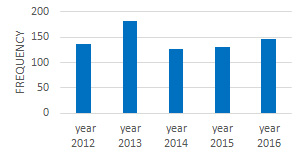
Figure
2:
Frequency
of
TB
Patients
according
to
Cities
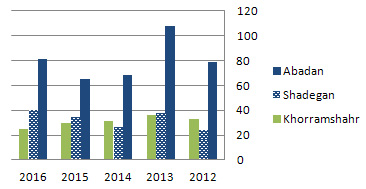
The
mean
age
of
patients
with
TB
was
41.39±17.69
with
an
age
range
of
4
to
92
years,
of
which
453
(62.9%)
and
267
(37.1%)
were
male
and
female
respectively,
which
shows
a
statistically
significant
difference.
The
mean
age
of
men
and
women
is
40.31
±
16.29
and
43.21±19.73
respectively,
which
is
not
statistically
significant.
The
results
are
calculated
separately
for
urban
and
rural
areas
that
show
530
(73.6%)
and
190
(26.4%)
of
them
lived
in
the
urban
and
rural
areas
respectively,
which
shows
a
statistically
significant
difference.
Table
1
provides
a
summary
of
the
demographic
data
of
TB
patients
based
on
information
obtained
from
the
Department
of
Health
of
Abadan
Faculty
of
Medical
Sciences.
Table
1:
The
details
of
demographic
characteristics
of
TB
patients
referred
to
Abadan
Health
Centers
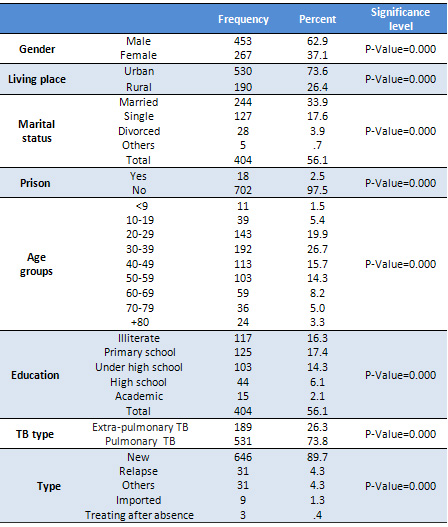
The
results
of
data
analysis
show
that
33.9%,
17.6%,
3.9%
and
0.7%
of
the
patients
were
married,
single,
divorced
and
patients
with
deceased
spouses,
and
there
was
a
significant
difference
among
them
pairwise
from
this
point
of
view;
i.e.
the
number
of
married
people
is
more
than
single,
more
than
divorced
and
more
than
a
patient
with
a
dead
spouse.
The
data
show
that
the
literacy
level
of
TB
patients
is
significantly
different,
with
16.3%
of
illiterate
patients,
17.4%
of
elementary
education,
14.3%
of
secondary
education,
6.1%
of
secondary
education
and
diploma
and
2.1%
university
degree.
The
following
results
were
obtained
with
regard
to
the
total
number
of
individuals
identified:
completed
the
treatment
period:
39.4%,
recovery
rate:
34.2%,
death
rate:
7.5%,
wrong
diagnosis:
3.2%,
absence
from
the
treatment
period:
4.2%,
were
treatment
failure:
2.8%,
transmitted
cases:
0.8%
and
ongoing
treatment
process:
7.9%.
The
results
of
TB
treatment
shows
a
significant
difference.
Of
the
total
population,
54
deaths
were
reported
from
TB
patients,
of
which
70.4%,
20.4%,
9.3%
and
9.3%
died
due
to
other
cases,
unknown
reasons
and
tuberculosis.
There
death
causes
differ
significantly
(Figure
3).
In
this
study,
a
total
of
720
TB
cases
were
investigated
in
Abadan
city
over
the
past
5
years.
The
prevalence
of
TB
and
pulmonary
TB
was
22.34
and
36.15
per
100,000
people,
respectively.
The
same
prevalence
rate
was
22.34
and
17.52
per
100,000
inhabitants
in
the
urban
and
rural
areas,
respectively.
Figure
3:
Percentage
of
Treatment
results
in
TB
Patients
Referred
to
Abadan
Health
Centers
(2012-2016)
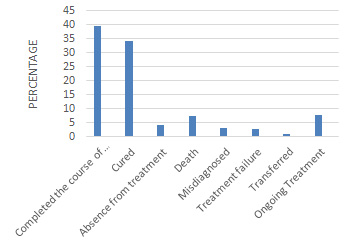
Figure
4
shows
that
the
prevalence
of
tuberculosis
in
men
and
women
living
in
the
urban
and
rural
areas
was
27.11,
17.28
and
22.23
12.69
per
100,000
people,
respectively.
The
prevalence
of
pulmonary
tuberculosis
was
15.36
per
100,000
people
during
the
last
5
years.
The
same
prevalence
rate
was
22.34
and
17.52
per
100,000
people,
respectively.
Figure
5
shows
the
frequency
of
TB
patients
per
100,000
people
based
on
their
place
of
residence
for
different
age
groups.
Figure
4:
Tuberculosis
incidence
rate
in
Abadan
Health
Centers
(2012-2016)
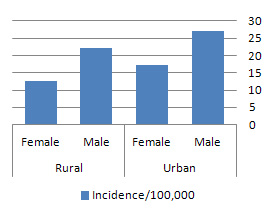
Figure
5:
Tuberculosis
incidence
rate
in
Abadan
Health
Centers
(2012-2016)
according
to
living
place
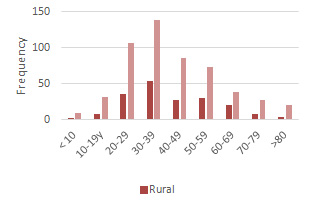
The
findings
of
this
study
revealed
that
the
highest
number
of
TB
patients
is
seen
in
the
age
group
of
30-39
years,
which
is
true
in
both
the
urban
and
rural
groups,
and
then
the
age
group
of
20-29
years
is
placed
in
the
next
ranking.
Nikbakht
et
al.
in
their
study
in
Babol
city
reported
the
age
group
of
18-38
years
as
the
group
with
highest
number
of
tuberculosis
patients
(7).
Gholami
et
al.
in
a
study
in
Urmia
found
that
the
highest
number
of
people
with
tuberculosis
was
seen
in
the
age
group
of
40
-31
years
(8).
Noeske
et
al.
also
reported
that
most
of
the
TB
patients
belonged
to
the
age
group
of
25-34
years
in
Cameroon(5).
In
a
study
in
Hamedan
province,
Khazaei
et
al.
(6)
reported
that
the
largest
TB
cases
occur
in
the
age
group
over
60
years
old,
which
is
more
consistent
with
the
TB
pattern
of
the
whole
country
(7).
It
seems
that
the
high
number
of
affected
people
in
the
age
group
of
20-39
years
old
is
due
to
the
high
population
of
this
age
group
and
the
high
prevalence
of
addiction
among
them.
In
the
present
study,
the
mean
age
of
the
patients
studied
was
41.39
±
17.79
years
with
an
age
range
of
4
to
92
years.
Also,
men
accounted
for
the
largest
number
of
patients.
In
a
study
in
northern
Iran
(9),
Babamahmoodi
et
al.
reported
that
the
mean
age
for
women
and
men
was
50.57
and
51.14
respectively,
and
the
majority
of
patients
were
male.
Fronti
and
Hoa
have
also
reported
a
higher
incidence
of
the
disease
among
men
in
their
studies
(10,
11).
In
a
study
in
France,
Cavalli
reported
a
mean
age
of
40
years
for
patients
(12).
According
to
World
Health
Statistics,
men
were
affected
by
the
disease
more
than
women(4).
In
a
study,
the
most
patients
were
affected
by
new
cases
of
disease
(89.8%).
Hoa
et
al.
(11)
also
reported
the
highest
incidence
of
new
cases.
In
general,
the
prevalence
of
the
disease
and
pulmonary
tuberculosis
in
this
study
was
22.34
and
15.36
per
100,000
people
respectively,
which
was
higher
than
the
average
prevalence
of
tuberculosis
in
the
whole
of
Iran(3),
which
is
12.6
per
100,000
people
for
all
TB
cases
and
8.57
per
100,000
for
pulmonary
tuberculosis.
The
prevalence
rate
reported
in
Cavalli
et
al.’s
study
(France)
(12)
and
Fronti’s
study
(Italy)
is
8.7
and
7.42
per
100,000
people,
respectively.
Considering
the
fact
that
tuberculosis
is
a
life-limiting
disease
and
is
most
prevalent
in
the
younger
age
group
of
society
that
is
considered
as
the
main
capital
and
workforce,
educating
people
who
at
risk
can
significantly
contribute
to
the
prevention
and
spread
of
disease.
Acknowledgement
This
research
was
financially
supported
by
student
research
committee
of
Abadan
school
of
medical
sciences
under
grant
No:
95ST-0072
with
ethical
code
of:
IR.ABADANUMS.REC.1396-198
1.
World
Health
Organization.
factsheet
no.
104-
Tuberculosis.
Available
at:
http://www.who.int/mediacentre/factsheets/fs104/en/
(Accessed
august
2017)
2.
Arsang
SH
,
Kazemnejad
A
,
Amani
F
Epidemiology
of
Tuberculosis
in
Iran
(2001-08).
Journal
of
Gorgan
University
of
Medical
Sciences.
2011;13(3):78-86.
3.
Tuberculosis
status,
Center
of
Disease
Control
and
Prevention
(Division
of
TB
and
Leprosy
Elimination),
ministry
of
health
and
medical
education,
Iran,
available
at:
http://tb-lep.behdasht.gov.ir/
(Accessed
august
2017).
4.
World
Health
Organization.
Global
Tuberculosis
report,
2015.
Available
at:
http://www.who.int/tb/publications/factsheet_global.pdf?ua=1.
5.
Noeske
J,
Nana
Yakam
A,
Abena
Foe
JL.
Epidemiology
of
tuberculosis
in
Cameroon
as
mirrored
in
notification
data,
2006-2014.
The
international
journal
of
tuberculosis
and
lung
disease
:
the
official
journal
of
the
International
Union
against
Tuberculosis
and
Lung
Disease.
2016;20(11):1489-94.
6.
Khazaei
S,
Roshanaei
G,
Saatchi
M,
Zahiri
A,
Bathaei
S,
Salehynia
H,
et
al.
Epidemiology
of
pulmonary
tuberculosis
in
the
Hamadan
province
during
2005-11.
2.
2015;3(6):12-9.
7.
Nikbakht
HA,
Hosseini
SR,
Sharifi-fathabad
H,
Habibzade
R,
Daemi
A,
Ghaffari-fam
S.
Clinical
epidemiology
and
treatment
findings
of
acute
tuberculosis
patients
in
Babol
City
(2009–2013).
Journal
of
Acute
Disease.
2016;5(3):216-21.
8.
Gholami
A,
Gharehaghaji
R,
Moosavi-Jahromi
L,
Ali
Sadaghiyanifar
A.
Epidemiologic
Survey
of
Pulmonary
Tuberculosis
in
Urmia
city
during
2004-2007.
Knowledge
&
Health
2009;4(3):19-23.
9.
Babamahmoodi
F,
Alikhani
A,
Yazdani
Charati
J,
Ghovvati
A,
Ahangarkani
F,
Delavarian
L,
et
al.
Clinical
epidemiology
and
paraclinical
findings
in
tuberculosis
patients
in
north
of
Iran.
BioMed
research
international.
2015;2015:381572.
10.
Fronti
E,
Vecchia
M,
Scudeller
L,
Pratico
L,
Marone
P,
Muzzi
A,
et
al.
Epidemiology
of
Mycobacterium
tuberculosis
infection
in
Pavia
province,
Lombardy,
Northern
Italy,
1998-2013.
New
Microbiol.
2016;39(4):264-8.
11.
Hoa
NB,
Wei
C,
Sokun
C,
Lauritsen
JM,
Rieder
HL.
Characteristics
of
tuberculosis
patients
at
intake
in
Cambodia,
two
provinces
in
China,
and
Vietnam.
BMC
public
health.
2011;11:367.
12.
Cavalli
Z,
Ader
F,
Valour
F,
Saison
J,
Boussel
L,
Dumitrescu
O,
et
al.
Clinical
Presentation,
Diagnosis,
and
Bacterial
Epidemiology
of
Peritoneal
Tuberculosis
in
Two
University
Hospitals
in
France.
Infect
Dis
Ther.
2016;5(2):193-9.
|
|
.................................................................................................................

|
| |
|

